|
FAQs on Anemone Identification
16
Related Articles: Anemones,
Bubble
Tip Anemones, LTAs, Cnidarians, Coldwater Anemones, Colored/Dyed Anemones,
Related FAQs: Anemone ID 1, Anemone ID 2, Anemone ID 3, Anemone ID 4, Anemone ID 5, Anemone ID 6, Anemone ID 7,
Anemone ID 8,
Anemone ID 9, Anemone ID 10, Anemone ID 11,
Anemone ID 12,
Anemone ID 13, Anemone ID 14, Anemone ID 15, Anemone ID 17, Anemone ID 18, Anemone ID 19, Anemone ID 20, Anemone ID 21, Anemone ID 22, Anemone ID 23, Anemone ID 24, Anemone ID 25, Anemone ID 26, Anemone ID 27, Anemone ID 28, Anemone ID 29, Anemone
ID 30, Anemone ID 31, Anemone ID 32, Anemone ID 33, Anemone ID 34, Anemone ID 35, Anemone ID 36, Anemone ID 37, Anemone ID 38, Anemone ID 39, Anemone ID 40, Anemone ID 41,
Anemone ID 42,
Anemone ID 43,
Anemone ID 44, Anemone ID 45,
& Cnidarian Identification, Anemones 1,
Anemones 2, Anemones 3, Anemones
4, Anemones 5, Invertebrate Identification, Aiptasia
Identification, Aiptasia ID
2, LTA
Identification, Bubble Tip
Anemones, Caribbean
Anemones, Condylactis, Aiptasia
Anemones, Other Pest
Anemones, Anemones and
Clownfishes, Anemone
Reproduction, Anemone
Lighting, Anemone Feeding,
Anemone Systems,
Anemone
Compatibility, Anemone
Selection, Anemone
Health, Anemone Behavior,
Anemone
Placement,
|
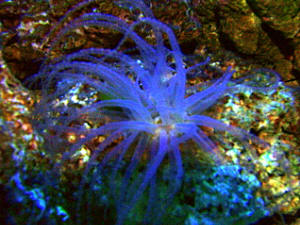
|
 |
New Print and
eBook on Amazon:
Anemone Success
Doing what it takes to keep Anemones healthy long-term
by Robert (Bob) Fenner
|
| Anemone identification 12/3/07 Hi Bob, Would
you be able to identify this? I couldn't find anything on the
website. Thanks for all the other answers I've already found on
your site. Ross <Likely an Anemonia cf. majano. RMF> |
|
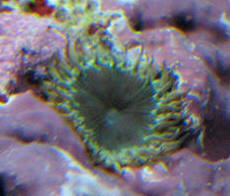
|
| Need an Id... Possibly Actinodendron plumosum
11/21/2007 Good day, we are Mathieu and Shelly from Alberta.
<Good day to you Mathieu and Shelly from Alberta, Mich here from
the snowy Pocono Mountains of Pennsylvania. Let me deeply apologize
for the delayed response.> We require some help to identify what
we believe to be an anemone of the family Actinodendron. <Does
look to be!> It came as a hitchhiker on the live rock we
purchased (Jakarta). We started out with one and it has multiplied
to eight. <Yikes!> It has a mouth <Yes.> and
doesn't sting. <Mmm, are you sure? Actinodendron spp. are
commonly called Hellfire anemones and with good reason. Take a look
on the net for some nasty reactions some folks have had. It's
not pretty!
http://www.gifte.de/Gifttiere/actinodendron_kontakt_bild01.htm See
page 185 and 186
http://books.google.com/books?id=YsZ3GryFIzEC&pg=PA186&lpg=PA186&dq=actinodendron+vesicles&source
=web&ots=tAKJ04saeA&sig=lWlZtlpgRpA_gpZBgIDLQu-9Wn8#PPA185,M1
> We have fed it and it's doing well. <Mmm, I'm not
so sure I would be encouraging it's well being.> Any help in
identifying it would be appreciated. <I believe it is an
Actinodendron plumosum, I am unaware of any other Actinodendron
spp. found in Jakarta, though yours does look a little
different.>
http://www.edge-of-reef.com/anemoni/ESAActinodendronplumosumen.htm
http://www.wetwebmedia.com/anempt2.htm >
http://i234.photobucket.com/albums/ee69/bioroots/NewAssortedPics2007043.jpg
http://i234.photobucket.com/albums/ee69/bioroots/NewAssortedPics2007028.jpg
http://i234.photobucket.com/albums/ee69/bioroots/NewAssortedPics2007025.jpg
Thanks and we hope to hear from you soon. <I'm sorry for the
delay. I do hope this is helpful to you. Mich> |
|
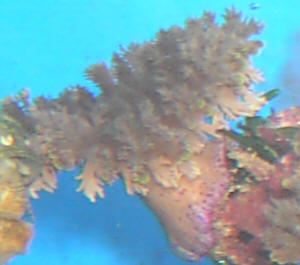 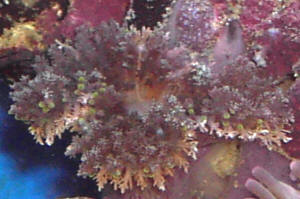
|
Hey Bob, its Niki. Got an anemone question here.
-11/19/07 Hey Bob, <Howzit Nik?> Hope this letter finds you
in good health and happiness...everything here at Quality is great and
just as you said it would be. (awesome company). <Yes... at the top
of the best two of its kind on the planet (the other TMC in the UK)...
Best set-up, folks, systems, suppliers... and livestock suppliers.
Indeed, Quality> My question pertains to the ever-so-daunting task
of identification. I am trying to get the pictures and the scientific
names matched up with our anemones in our catalog. Our Bob here
mentioned you would be just the person to ask. I did go on WWM but
could not find specifically the answer to my question. I am trying to
get ironed out the malu and crispa thing, is H. malu an obsolete name?
Did they merge it into H. crispa? <Mmm, no... or should I remark,
"not as far as I'm aware"... Same genus, different
species... the Sebae is almost always readily identifiable with its
"tips" coloring... and the pedicles of both are very
different...> Also in our catalog we have 'Sebae' describing
H. malu in our common names. Here is a link, it all just looks wrong to
me.
http://qualitymarineusa.com/products.asp?cls=2&scls=5&cat=50&scat=538&pg=1
Can you tell me what you think? Or refer me to a good reference online
or a good book for identifying anemones? <The two pix shown look
okay to me... as far as species ID goes. The best site, links period
for hexacorallians are Daphne Fautin:
http://hercules.kgs.ku.edu/Hexacoral/Anemone2/> Also is malu a sand
anemone, or a type of LTA? <The Malu could be called a sand
anemone... the LTA is a different species. Please see here:
http://wetwebmedia.com/marine/inverts/cnidaria/anthozoa/anemones.htm>
I have found indications of both. <There is MUCH mis- and
dis-information about. Am asking friend/anemone guru Brenda Furtak to
chime in here> Thanks so much, your friend Niki <Cheers, Bob
Fenner>
Polyp ID 10/25/07 ID... AiptasiaHi
Crew, <Hello Tisheena & Danny, Mich here.> We have had
our daisy polyps in our tank for about three months, and
they've been doing great so far. A few weeks ago we noticed
another type of polyp (presumably) growing among the daisies (see
attached pic). Now, wherever these new tentacle-looking polyps are
growing, the nearby daisies won't open. We're not sure
whether this new species is a harmful intruder. <It is a harmful
intruder. It is Aiptasia and should be eliminated.> If you have
any suggestions for saving our daisies, we'd appreciate it!
<More here:
http://www.wetwebmedia.com/marine/inverts/cnidaria/anthozoa/Aiptasia/aiptasia.htm
http://www.wetwebmedia.com/ca/cav1i3/aiptasia_impressions/aiptaisia_impressions.htm>
Thanks!<Welcome! Mich>
Tisheena & Danny |
|
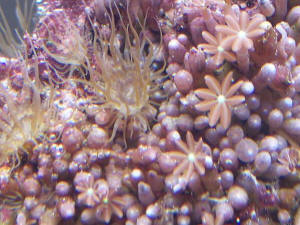
|
Anemone Identification 10/20/07 Hello WetWebMedia
Staff People! <Hi Kevin> As my subject suggests, I need help in
identifying an anemone that I am attempting to purchase. I am trying to
complete my fishtank with a Heteractis malu, <Difficult critter to
keep/acclimate.> but I'm having issues going to different LFSs
and finding the one I want. I've seen different anemones that look
like long tentacle anemones, Heteractis crispa and Heteractis malu, but
at some point they all seem to be labeled as sebae anemones. <One
and the same. Read here.
http://www.wetwebmedia.com/marine/inverts/cnidaria/anthozoa/heteraccrispa.htm><<...
these are separate species... RMF>> I have tried doing picture
searches online to try and distinguish which anemone is which, but the
pictures seem to come up looking very much the same. The WWM pictures
are too small for me to effectively identify the anemone I'm
looking for. What are the clear differences between the three anemones
that can help me distinguish one from the other, including foot /
tentacle color, etc? <Oboy, as far as color, it will depend on how
healthy the anemone is. They generally do not ship to well. But
I'll give it my best. Heteractis Magnifica can grow to an enormous
size of about three foot and the tentacles are greenish in color with
purple tips. Heteractis Aurora, sometimes called the Beaded Anemone,
has characteristic knobs on the tentacles and a striped oral area. It
likes to bury it's column in the sand. Heteractis Malu likes to do
the same and has short tentacles creamy in color with small purple
tips. Heteractis Crispa has numerous long pointed tentacles creamy in
color, and is one of the more commonly found anemones.> The reason
for me attempting to get a Heteractis Malu is because its occasional
appearance in certain parts of Hawaii. I decided a while back that I
wanted to have a Hawaii themed aquarium, not including those pesky
triggers or butterflies that eat inverts. Thanks for all of your help!
<You're welcome. James (Salty Dog)> Kevin <<See here as
well:
http://www.wetwebmedia.com/marine/inverts/cnidaria/anthozoa/anemones.htm.
RMF>>
| Identify Anemone 10/16/07 Hi there
<Howdy> I've only had a marine tank for a few months now
and have acquired this anemone. Would you be able to identify it
for me and tell me where to look up some information on it. Thanks
very much Brett, South Africa. <Looks like a Heteractis malu to
me. Bob Fenner> |
|
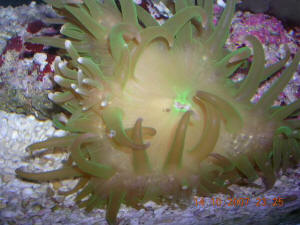 .jpg)
|
| Help me figure out what's Going on please...
Sm. SW... pest anemones mostly... Attention... is... narrowed...
perception 10/3/07 Hi All, <Amy> I have not
written since my sebae anemone problem. We took him back as told
and all was well. The tank has been pretty much the same since. We
just kind of let it ride over the summer. I swear I have aquarium
ADD. I look and read and search and get so far off track that until
I look in the tank, I forget what the question was. <More rest,
less distractions?> First my tank is a BioCube 29 with two 105
watts of light (that's what my husband said), a sapphire
protein skimmer. The water is 0 Nitrates, 0 Ammonia, 83 PH and
15-20 Nitrates (hard for me to match the colors). It's been up
for 9 months and is home to a blue damsel, 2 Nemos, one lawn mower
blenny, <Needs more room than this> one emerald crab, 8
little hermit crabs, 2 turbo snails, mushroom rock, a rock anemone
and the rock I'm sending pictures of. Well, I think we have
Aiptasia. <Mmm, no Anemonia sp.> I took out the rock that was
covered. This rock in the pictures came with yellow thingy's
(don't yell, I can't find what they are) and brown buttons.
<Zoanthids> We already had some brown buttons. The yellow
guys won't open and haven't for a while. Is it because of
the Aiptasia? Or maybe the water, light, lack of nutrients, etc. Am
I supposed to feed them? I know, you can't see what they are.
They look a lot like the brown ones. Plus, what is with that gray
lump on the top of that one. <Maybe> Do our mushrooms look
ok? <Yes> They don't seem to extend as much as the ones
in the store. We also have a million bristle worms and these little
flea bugs that run around at night along with all kinds of little
snails. No one is looking ill so I believe everything is fine
there. I will read more how to control the nutrients. We have
stepped up the water changes and want everyone to be happy. Any
ideas? I'm guessing that injecting them with lemon juice
isn't your first method of removal. I read that somewhere. I
don't want to hurt the other guys though. I included a pic of
the Nemo's because they are so darn cute. Do you think
they'll ever have babies? Also, Lenny the ever loving Blenny is
getting quite large. Around 7 inches I'd guess. He seems happy
enough, can we keep him? Humbly Yours, Amy <Read here:
http://www.wetwebmedia.com/marine/inverts/index.htm scroll down to
the tray on Anemones... Pests... Bob Fenner> |
|
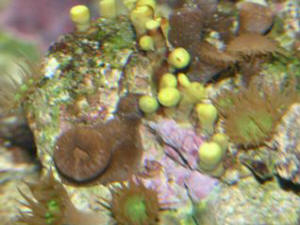
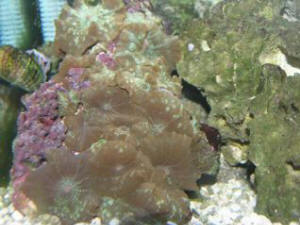
|
Creature identification: Is This an Aiptasia?
Don't Think So... Perhaps a Tube Anemone 9/30/07
I've had my tank up for about 10 months now and it's doing
great. <Good to hear!> Not long after I got my live rock, I
noticed a small, tentacled creature on it. Since then it's
grown a lot. I've attached a picture of said creature (I'm
no photographer). I've looked at many pictures and can't
decide if this is an Aiptasia. <Mmm, I don't think so.>
It has an obvious mouth in the center but the base is not long but
is quite thick. I would appreciate your input as to what you think
it is. <Might be a tube anemone. If so, watch you fish don't
become a tasty snack. More here:
http://www.wetwebmedia.com/tubeanem.htm > I know its tentacles
are "sticky" because if I put my feeding stick around it
they grasp it. It does retreat some when touch but it doesn't
fully withdraw in to the rock. I don't have an outbreak of
these creatures either. Also, you guys have a great site. I spend
many hours just reading all the stuff! <Thank you for the kind
words.> Thanks.
<Welcome! Mich> |
|
 Might be... gorgeous. RMF. Might be... gorgeous. RMF.
|
|
|

